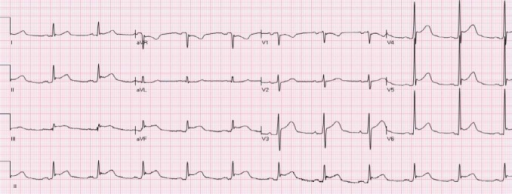Playlist
Show Playlist
Hide Playlist
ECG Case: 17-year-old Man with Pressure Feeling under Sternum
-
Slides ECG of Myocardial Infarction.pdf
-
Reference List Electrocardiogram (ECG) Interpretation.pdf
-
Download Lecture Overview
00:00 Let's look at the second case: 17-year-old student comes to the hospital complaining of pressure feeling under his sternum, under the breastbone. 00:09 It's been going on for 2 hours, gets worse when he takes a deep breath, and his physical exam is normal for a 17-year-old. 00:16 He's -- what's important here, long-lasting precordial discomfort and it worsens with inspiration, so-called pleuritic chest pain. 00:24 And here's his ECG. 00:27 Take a look at it for a moment and see if you see a STEMI here in ST elevation MI. 00:39 Of course, this is the ECG with diffused ST elevation. 00:43 ST elevation in lead 1, in 2, in 3, in aVL, in aVF, in V1, V2, and V3. 00:52 And even further out, even V4 and 5 also have ST elevation. 00:57 So diffused ST segment elevation, what's the diagnosis? It's pericarditis. 01:03 There's no reciprocal changes, there's no reciprocal depression, and STEMIs don't affect all the leads like this. 01:11 We do an echocardiogram. 01:13 Oh, there's a little bit of fluid around the heart, pericardial effusion. 01:17 So this is pericarditis, almost certainly viral, and the good news is it's usually treated with colchicine and a non-steroidal such as ibuprofen. 01:27 Two weeks later, the patient has no symptom. He's active again. 01:31 He doesn't have any recurrence and he does very well. We see this all the time. 01:35 It's a very common thing, viral pericarditis.
About the Lecture
The lecture ECG Case: 17-year-old Man with Pressure Feeling under Sternum by Joseph Alpert, MD is from the course Electrocardiogram (ECG) Interpretation.
Included Quiz Questions
A 17-year-old student comes to the hospital complaining of a pressure feeling under his sternum which has lasted for 2 hours and gets worse when he takes a deep breath. His physical exam is unremarkable. Which of the following statements about this case is false?
- Viral pericarditis has a very high mortality rate.
- The diffuse ST segment elevation without reciprocal changes indicates a diagnosis of pericarditis.
- Pleuritic chest pain is chest pain that is worse with inspiration.
- The pericarditis observed in this case can be appropriately treated with colchicine and ibuprofen.
- Viral pericarditis is more common than bacterial pericarditis.
Customer reviews
5,0 of 5 stars
| 5 Stars |
|
1 |
| 4 Stars |
|
0 |
| 3 Stars |
|
0 |
| 2 Stars |
|
0 |
| 1 Star |
|
0 |
Awesome Lectures Dr. Alpert. Speed of talk and articulations excellent. Thank you!




